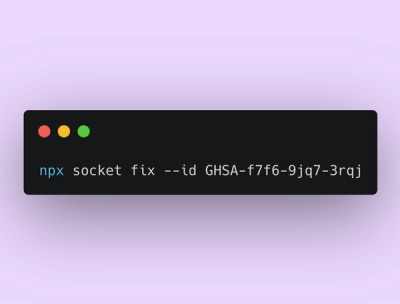
Product
Rust Support Now in Beta
Socket's Rust support is moving to Beta: all users can scan Cargo projects and generate SBOMs, including Cargo.toml-only crates, with Rust-aware supply chain checks.
AdaptiveTimer executes a workload at a designated interval while minimizing variance. It is designed for use in single-threaded applications using cooperative multitasking, such as those running on microcontrollers with MicroPython.
For example, the following code intends to execute do_something() once every second:
async def do_something_every_second():
while True:
do_something()
await asyncio.sleep(1)
However, the actual interval in which do_something() executes may vary from 1 second due to:
The Hello, World! example demonstrates this along with how to apply AdaptiveTimer to reduce the variance.
The start(get_value) and stop() instance methods of AdaptiveTimer control a loop that:
While the loop is sleeping, tasks awaiting on the value() instance method will execute and process the value.
This example uses AdaptiveTimer to print a message every second, while compensating for a 0.75 second workload that is toggled on/off every 5s.
The shell commands below assume use of Linux/MacOS.
$ python --version
Python 3.13.1
$ python -m venv .venv
$ source .venv/bin/activate
(.venv) $
(.venv) $ pip install adaptive-timer
Collecting adaptive-timer
Downloading adaptive_timer-0.3.5-py3-none-any.whl.metadata (23 kB)
Collecting pycopy-cpython-utime>=0.5.2 (from adaptive-timer)
Using cached pycopy_cpython_utime-0.5.2-py3-none-any.whl
Downloading adaptive_timer-0.3.5-py3-none-any.whl (11 kB)
Installing collected packages: pycopy-cpython-utime, adaptive-timer
Successfully installed adaptive-timer-0.3.5 pycopy-cpython-utime-0.5.2
# Print 'Hello, World!' every 1s while toggling on/off an extra 0.75s load every 5s
import asyncio
import time
from adaptive_timer import AdaptiveTimer
async def loop():
def workload():
nonlocal t, i
suffix = ""
if int(i / 5) % 2 == 1:
suffix = " (with 0.75s load)"
time.sleep(0.75)
now = time.time()
print(f"Hello, World! Time since last message: {now-t:.3f}{suffix}")
t = now
i += 1
t = time.time()
i = 0
await AdaptiveTimer(1).start(workload)
asyncio.run(loop())
(.venv) $ python hello_world.py
Hello, World! Time since last message: 0.000
Hello, World! Time since last message: 1.001
Hello, World! Time since last message: 1.000
Hello, World! Time since last message: 1.000
Hello, World! Time since last message: 1.001
Hello, World! Time since last message: 1.755 (with 0.75s load)
Hello, World! Time since last message: 0.998 (with 0.75s load)
Hello, World! Time since last message: 1.001 (with 0.75s load)
Hello, World! Time since last message: 1.001 (with 0.75s load)
Hello, World! Time since last message: 1.000 (with 0.75s load)
Hello, World! Time since last message: 0.245
Hello, World! Time since last message: 1.000
Hello, World! Time since last message: 1.000
Hello, World! Time since last message: 1.000
Hello, World! Time since last message: 1.000
Hello, World! Time since last message: 1.753 (with 0.75s load)
Hello, World! Time since last message: 1.001 (with 0.75s load)
Hello, World! Time since last message: 1.001 (with 0.75s load)
Hello, World! Time since last message: 0.997 (with 0.75s load)
Hello, World! Time since last message: 1.003 (with 0.75s load)
Hello, World! Time since last message: 0.245
Hello, World! Time since last message: 1.000
Hello, World! Time since last message: 1.000
Hello, World! Time since last message: 1.000
Hello, World! Time since last message: 1.000
Hello, World! Time since last message: 1.755 (with 0.75s load)
Hello, World! Time since last message: 1.000 (with 0.75s load)
Hello, World! Time since last message: 1.000 (with 0.75s load)
Hello, World! Time since last message: 1.000 (with 0.75s load)
Hello, World! Time since last message: 1.000 (with 0.75s load)
Hello, World! Time since last message: 0.245
Hello, World! Time since last message: 1.000
Hello, World! Time since last message: 1.000
Hello, World! Time since last message: 1.000
Hello, World! Time since last message: 1.000
Hello, World! Time since last message: 1.755 (with 0.75s load)
Hello, World! Time since last message: 1.000 (with 0.75s load)
Hello, World! Time since last message: 1.000 (with 0.75s load)
Hello, World! Time since last message: 1.000 (with 0.75s load)
Hello, World! Time since last message: 0.997 (with 0.75s load)
Hello, World! Time since last message: 0.248
Hello, World! Time since last message: 1.000
^CTraceback (most recent call last):
Ignore the stack trace that appears - there is no exception handling in this example.
AdaptiveTimer automatically attempts to compensate when the actual interval deviates from the target (1s, in this example.) When the workload appears, the interval temporarily increases proportionately, but then returns to the target interval as AdaptiveTimer compensates in its internal cycle. The opposite happens when the workload is removed.
This section provides a side-by-side comparison of a simple application that attempts to print a message at exactly 1-second intervals. In the first example, the interval is achieved by calling asyncio.sleep(), while the second interval is modified to use AdaptiveTimer.
example_1.py measures the actual time spent in a cycle of do_something_every_second() given a 0.1s time cost for do_something() and a competing coroutine, noisy_neighbor():
def do_something():
global previous, interval_history
sleep(0.1) # Simulate a workload of 0.1s
now = time()
if previous is not None:
actual_interval = now - previous
interval_history.append(actual_interval)
print(f"Hello, World! actual_interval: {actual_interval:.3f}s")
previous = now
async def do_something_every_second():
while True:
do_something()
await asyncio.sleep(0.9) # deducting .1s to compensate for known workload
async def noisy_neighbor():
while True:
# Simulate a workload of 0.5s with +/- 50% variation and 0.25s pause
noisy_workload = random.uniform(0.25, 0.75)
sleep(noisy_workload)
await asyncio.sleep(0.25)
To make the comparison more fair, do_something_every_second() sleeps for 0.9s rather than the target interval of 1.0s. A developer would likely make this adjustment knowing that do_something() imparts a 0.1s time cost.
From the project directory, execute src/examples/example_1.py for a few iterations then press ctrl-c to terminate:
[adaptive-timer]$ python src/examples/example_1.py
Hello, World! actual_interval: 1.378s
Hello, World! actual_interval: 1.006s
Hello, World! actual_interval: 1.137s
Hello, World! actual_interval: 1.578s
Hello, World! actual_interval: 1.007s
Hello, World! actual_interval: 1.007s
Hello, World! actual_interval: 1.540s
Hello, World! actual_interval: 1.064s
Hello, World! actual_interval: 1.006s
Hello, World! actual_interval: 1.122s
Hello, World! actual_interval: 1.007s
Hello, World! actual_interval: 1.153s
^C
mean(actual_interval): 1.1670
variance(actual_interval): 0.0692 (relative to 1s target)
[adaptive-timer]$
The statistics show the mean interval and statistical variance relative to the target of 1s. These are used for comparison with the following example.
example_2.py adapts example_1.py to use AdaptiveTimer to achieve the desired interval of 1s:
async def do_something_every_second():
await AdaptiveTimer(1).start(do_something)
Execute src/examples/example_2.py for a few iterations then press ctrl-c to terminate.
[adaptive-timer]$ python src/examples/example_2.py
Hello, World! actual_interval: 1.373s
Hello, World! actual_interval: 0.736s
Hello, World! actual_interval: 1.324s
Hello, World! actual_interval: 0.713s
Hello, World! actual_interval: 1.282s
Hello, World! actual_interval: 0.862s
Hello, World! actual_interval: 0.816s
Hello, World! actual_interval: 1.502s
Hello, World! actual_interval: 0.593s
Hello, World! actual_interval: 0.905s
Hello, World! actual_interval: 1.000s
^C
mean(actual_interval): 1.0097
variance(actual_interval): 0.0868 (relative to 1s target)
The result above shows how using AdaptiveTimer results in intervals that are closer to the 1s target.
usage_1.py demonstrates how AdaptiveTimer can be used in a basic producer/consumer application.
This is useful when downstream processing (such as storage, display, or transmitting) needs to occur whenever an updated value is available.
timer = AdaptiveTimer(1)
def produce_value():
return random.randint(0, 100)
async def produce_value_every_second():
await timer.start(produce_value)
async def consume_values():
while True:
value = await timer.value()
print(f"Value: {value}")
AdaptiveTimer (timer, in these examples) executes produce_values() once every second, and makes the latest result available through value()
consume_values() is a second coroutine that awaits timer.value() until a new value is produced. This allows multiple consumers to be notified without the need for polling.
For IoT devices using MicroPython, this is a useful pattern to follow for processing sensor input, just replace random.randint() with hardware-specific instructions.
Execute src/examples/usage_1.py for a few iterations and exit by pressing ctrl-c:
[adaptive-timer]$ python src/examples/usage_1.py
Value: 64
Value: 24
Value: 53
Value: 28
Value: 15
Value: 69
Value: 22
Value: 7
Value: 51
Value: 39
^CExiting.
In the previous examples, AdaptiveTimer has been allowed to run indefinitely until interrupted by the user. To programmatically stop AdaptiveTimer, use its stop() instance method.
Note: : It is up to the application to ensure other coroutines/tasks are cancelled after stop() is executed. Otherwise, those routines may become deadlocked awaiting timer.value()
usage_2.py modifies consume_values() to exit and stop timer after 10 iterations:
interval = 0
async def consume_values():
global interval
while interval < 10:
interval += 1
value = await timer.value()
print(f"Value({interval}): {value}")
timer.stop()
It also introduces a minor modification in main() to print "Goodbye!" when the application exits naturally:
...
try:
loop.run_until_complete(asyncio.wait(tasks))
except KeyboardInterrupt:
print("Exiting.")
else:
print("Goodbye!")
finally:
for task in tasks:
task.cancel()
Executing src/examples/usage_2.py shows the result of these changes:
[adaptive-timer]$ python src/examples/usage_2.py
Value(1): 44
Value(2): 95
Value(3): 15
Value(4): 13
Value(5): 2
Value(6): 8
Value(7): 0
Value(8): 20
Value(9): 48
Value(10): 58
Goodbye!
[adaptive-timer]$
There may be times when an application needs to change the target interval after timer.start() is called, for example in response to user input. This is accomplished by setting the interval property of an AdaptiveTimer.
Executing src/examples/usage_3.py demonstrates this by reducing the interval from 1s to 0.5s after 5 iterations:
async def consume_values():
global interval
while interval < 10:
interval += 1
value = await timer.value()
print(f"Value({interval}): {value}")
if interval == 5:
print("Setting the timer interval to 0.5s.")
timer.interval = 0.5
timer.stop()
[adaptive-timer]$ python src/examples/usage_3.py
Value(1): 47
Value(2): 23
Value(3): 80
Value(4): 13
Value(5): 25
Setting the timer interval to 0.5s.
Value(6): 80
Value(7): 10
Value(8): 18
Value(9): 80
Value(10): 22
Goodbye!
[adaptive-timer]$
This example demonstrates how to configure AdaptiveTimer to raise an exception when the variance exceeds a designated maximum. By default, the variance is unbounded.
First step is to modify consume_values() in usage_4.py to display the variance, and to introduce an additional delay on the 7th iteration:
async def consume_values():
global interval
while interval < 10:
interval += 1
value = await timer.value()
state = timer.state()
print(
f"Value({interval}): {value} "
f"Actual Interval: {state['actualInterval']} "
f"Variance: {state['variance']}"
)
if interval == 5:
print("Setting the timer interval to 0.5s.")
timer.interval = 0.5
if interval == 7:
sleep(0.75)
timer.stop()
This introduces AdaptiveTimer.state() which is useful for getting the internal state of the timer for testing or debugging purposes. A full list of attributes available via this method is described in section Introspection
The delay is being introduced in a contrived manner here for simplicity. In practice, unexpected delays can happen for many reasons, such as I/O delays or exceptions in other coroutines.
Executing src/examples/usage_4.py shows an approximately 51% variance between intervals 7 and 8:
[adaptive-timer]$ python src/examples/usage_4.py
Value(1): 35 Actual Interval: None Variance: None
Value(2): 22 Actual Interval: 1.001 Variance: 0.001
Value(3): 50 Actual Interval: 1.001 Variance: 0.001
Value(4): 92 Actual Interval: 0.999 Variance: -0.001
Value(5): 41 Actual Interval: 1.001 Variance: 0.001
Setting the timer interval to 0.5s.
Value(6): 82 Actual Interval: None Variance: None
Value(7): 1 Actual Interval: 0.501 Variance: 0.002
Value(8): 8 Actual Interval: 0.756 Variance: 0.512
Value(9): 92 Actual Interval: 0.244 Variance: -0.512
Value(10): 40 Actual Interval: 0.501 Variance: 0.002
Goodbye!
[adaptive-timer]$
This is allowed to pass because instance attribute max_variance is None by default.
Modifying the initialization of timer as shown below will result in an exception if the variance exceeds 25% (positive or negative.)
timer = AdaptiveTimer(1, max_variance=0.25)
src/examples/usage_5.py contains this minor modification, and running it results in a ValueError exception being thrown:
[adaptive-timer]$ python src/examples/usage_5.py
Value(1): 22 Actual Interval: None Variance: None
Value(2): 48 Actual Interval: 1.002 Variance: 0.002
Value(3): 9 Actual Interval: 0.999 Variance: -0.001
Value(4): 16 Actual Interval: 1.001 Variance: 0.001
Value(5): 78 Actual Interval: 0.998 Variance: -0.002
Setting the timer interval to 0.5s.
Value(6): 63 Actual Interval: None Variance: None
Value(7): 65 Actual Interval: 0.501 Variance: 0.002
Value(8): 40 Actual Interval: 0.754 Variance: 0.508
Timer interval of 0.754s deviates more than 25.00% from expected interval of 0.5s
[adaptive-timer]$
The optimal value for max_variance depends on the natural volatility of the application, which is minimal in these examples. The section on Simulation provides a visualization of variance under a greater variety of workloads.
async def start(self, get_value, exception_handler=None)
start() supports a second callback, exception_handler. If provided, any exception raised by get_value is first sent to exception_handler, and if not handled, raised up through AdaptiveTimer.
This is useful for dealing with intermittent hardware failures that prevent a value from being calculated.
By default, any exceptions raised while calling the get_value parameter of timer.start() are propagated up through AdaptiveTimer, essentially treating any exception as fatal.
usage_6.py demonstrates this by modifying an earlier example to raise an exception on the 5th iteration, and have it handled (swallowed) by providing a custom exception handler to timer.start():
interval = 0
def produce_value():
if interval == 5:
raise Exception("Simulating an error condition in the callback")
return random.randint(0, 100)
def producer_exception_handler(e):
print(f"Handling exception and carrying on: {e}")
async def produce_value_every_second():
await timer.start(produce_value, producer_exception_handler)
Executing src/examples/usage_6.py demonstrates this:
[adaptive-timer]$ python src/examples/usage_6.py
Value(1): 34
Value(2): 73
Value(3): 38
Value(4): 85
Handling exception and carrying on: Simulating an error condition in the callback
Value(5): None
Value(6): 79
Value(7): 17
Value(8): 11
Value(9): 100
Value(10): 36
Goodbye!
[adaptive-timer]$
def state(self) -> dict[str, int | float | None]:
The state() instance method of an AdaptiveTimer returns a dictionary containing its internal state. This is useful for testing and visualization, as demonstrated in usage_5.py and simulator.py (introduced in a following section)
The following properties are returned:
simulator.py executes an AdaptiveTimer at a designated target_interval and with a simulated workload. It then plots the resulting actual_interval and variance to show how well the AdaptiveTimer is able to maintain the target_interval.
In addition to adaptive-timer, install NumPy and Matplotlib:
(.venv) $ pip install adaptive-timer numpy matplotlib
Before running any of the following (scenarios), edit the Scenario class in simulator.py. Jump ahead to Sample Scenarios below to begin executing simulations.
class Scenario:
"""Collection of configuration attributes"""
target_interval = 0.1
max_variance = None
workload = lambda: Workload.oscillate(50, SCENARIO.target_interval * 0.25)
target_interval : Expected duration of each interval, in seconds.
max_variance : Defines the upper limit for variance. If specified, a ValueError will be raised if exceeded.
workload : Defines the amount of simulated workload that is generated at each interval.
To execute one of these scenarios, first modify the Scenario class as indicated then execute simulator.py. Close the window to exit.
Executes with a fixed load of 30% of target_interval:
In simulator.py:
class SCENARIO:
"""Collection of configuration attributes"""
target_interval = 0.25
max_variance = None
workload = lambda: Workload.constant(SCENARIO.target_interval * 0.30)

With a load of 0.075s, AdaptiveTimer corrects the initial variance by maintaining an offset of -0.077s. The additional 0.002s is compensating for other processing, such as the overhead of the Matplotlib graphing library.
This demonstrates how AdaptiveTimer is able to maintain the target interval when presented with a oscillating workload. As with the previous example, the peak workload is limited to 30% of the target, and the actual interval remains closely aligned to the target interval.
In simulator.py:
class SCENARIO:
"""Collection of configuration attributes"""
target_interval = 0.25
max_variance = None
workload = lambda: Workload.oscillate(50, SCENARIO.target_interval * 0.30)

Notice how the maximum deflection of the variance occurs when the workload delta is greatest. This reflects the currently reactive nature AdaptiveTimer, where it can only apply a corrected offset based on the variance of the previous interval.
Similar to the previous example, but with a higher maximum workload of 75% of the target to demonstrate what happens when the timer is not able to further compensate for a high variance.
In simulator.py:
class SCENARIO:
"""Collection of configuration attributes"""
target_interval = 0.25
max_variance = None
workload = lambda: Workload.oscillate(50, SCENARIO.target_interval * 0.75)

The shaded areas indicate where the offset has reached -target_interval, and therefore AdaptiveTimer cannot shorten the interval further.
Sets an upper limit on the variance to force an exception:
In simulator.py:
class SCENARIO:
"""Collection of configuration attributes"""
target_interval = 0.25
max_variance = 0.2
workload = lambda: Workload.oscillate(50, SCENARIO.target_interval * 0.90)
Increasing the workload and setting a maximum variance of 20% raises the exception as expected, indicating that the AdaptiveTimer failed to maintain an interval within max_variance:

Press enter/return in the terminal to exit the application:
[adaptive-timer]$ python src/examples/simulator.py
Timer interval of 0.304s deviates more than 20.00% from expected interval of 0.25s
Press the Enter/Return key to exit.
This scenario is more for fun and/or observing improvements:
In simulator.py:
class SCENARIO:
"""Collection of configuration attributes"""
target_interval = 0.25
max_variance = None
workload = lambda: Workload.random(SCENARIO.target_interval * 0.7, 0.30)
This generates random workloads that vary +/- 30% from 0.175 (70% of the target interval)

Such an unpredictable environment makes it a challenge to maintain a steady interval, however this is where setting max_variance can be helpful to throw an exception in the event that the environment unexpectedly become chaotic or overwhelmed.
FAQs
Executes a workload at a designated interval while minimizing time variance
We found that adaptive-timer demonstrated a healthy version release cadence and project activity because the last version was released less than a year ago. It has 1 open source maintainer collaborating on the project.
Did you know?

Socket for GitHub automatically highlights issues in each pull request and monitors the health of all your open source dependencies. Discover the contents of your packages and block harmful activity before you install or update your dependencies.

Product
Socket's Rust support is moving to Beta: all users can scan Cargo projects and generate SBOMs, including Cargo.toml-only crates, with Rust-aware supply chain checks.

Product
Socket Fix 2.0 brings targeted CVE remediation, smarter upgrade planning, and broader ecosystem support to help developers get to zero alerts.

Security News
Socket CEO Feross Aboukhadijeh joins Risky Business Weekly to unpack recent npm phishing attacks, their limited impact, and the risks if attackers get smarter.